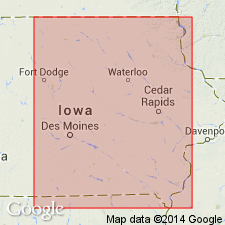
- Usage in publication:
-
- Gilmore City limestone
- Modifications:
-
- Original reference
- Dominant lithology:
-
- Limestone
- AAPG geologic province:
-
- Iowa shelf
Summary:
Pg. 113-114. [Author does not state that he is naming the beds described, but he uses Gilmore City limestone in three places, and it is in index to volume. As described, the beds in Gilmore Portland Cement Company's quarry, 1.5 miles northwest of Gilmore City, Pocahontas County, consist of about 41 feet of limestone of Kinderhook age, which is said to be probably older than Humboldt oolite, to resemble lithologically Alden limestone, to rest on brownish dolomitic limestone assigned to Kinderhook group, and to be possibly = Iowa Falls dolomite, but "correlation is uncertain."]
Source: US geologic names lexicon (USGS Bull. 896, p. 820-821).
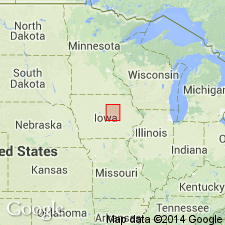
- Usage in publication:
-
- Gilmore City limestone
- Modifications:
-
- Biostratigraphic dating
- AAPG geologic province:
-
- Iowa shelf
Summary:
Pg. 349, 416-417. Alden limestone of Hardin County and Gilmore City limestone of Humboldt and Pocahontas Counties suggest Spergen [limestone] both lithologically and faunally. The large crinoid fauna in base of Gilmore City limestone carries large number of Kinderhook genera. Alden limestone, which is correlated with Gilmore City limestone, lies unconformably on upper surface of Iowa Falls member of Hampton formation. This relation seems to suggest they should not be considered of Kinderhook age. [p. 349.] Alden limestone is correlated with oolitic limestone exposed near Humboldt and Gllmore City. Exact age of fauna of Gllmore City limestone is doubtful, but It is considered younger than the Kinderhook because of the fauna and the marked unconformity which separates it from upper beds of the Kinderhook. Fauna as a whole resembles certain parts of fauna of Madison limestone of the West. Type section of Gilmore City beds consists of (descending): (1) Thin-bedded white oolitic limestone, numerous joints filled with green shale (CYATHOPHYLLUM zone), 14 feet; (2) very massive hard grayish-white crystalline cross-bedded oolitic limestone, fossiliferous throughout but more so near the base (STREPTORHYNCHUS zone), 18 feet; (3) massive greenish limestone interbedded with green shale (RHODOCRINUS zone), 8 feet; (4) soft blue shaly limestone (CAMAROTOECHIA zone), 3 feet. [In his 1933 paper he called this RHYNCHOPORA zone]; (5) brecciated limestone, 2 feet [p. 416-417. In his 1933 paper cited below, No. 5 of type section of Gilmore City formation is described as 15 feet of limestone, gray, lithographic, banded, carrying a brown limestone member in base and a brown shaly limestone member in top; no fossils.]
Source: US geologic names lexicon (USGS Bull. 896, p. 820-821).
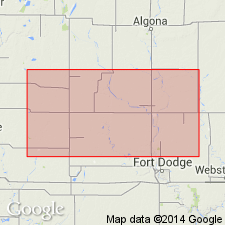
- Usage in publication:
-
- Gilmore City formation
- Modifications:
-
- Areal extent
- Biostratigraphic dating
- AAPG geologic province:
-
- Iowa shelf
Summary:
Gilmore City formation consists almost entirely of gray, white, or blue cross-bedded sandstone. Thickness 210 feet. Is unconformably overlain by St. Louis limestone and unconformably underlain by Iowa Falls member of Hampton formation. Writer believes the formation represents an eastward invasion of some portion of Madison sea of the West. [Listed fauna and described and discussed it.] At first glance one is impressed with similarity of this fauna with that of Spergen formation. A close examination, however, will reveal that it is not the Spergen fauna and that it is far older. It has its closest affinities with the molluscan fauna of the Wassonville member of Hampton formation (Kinderhook). [Writer treated the Gilmore City as top formation of Kinderhook.]
Source: US geologic names lexicon (USGS Bull. 896, p. 820-821).
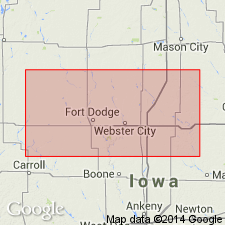
- Usage in publication:
-
- Gilmore City formation
- Modifications:
-
- Biostratigraphic dating
- AAPG geologic province:
-
- Iowa shelf
Summary:
Pg. 247. Gilmore City formation. Moore revives old term Alden and correlates the formation with Spergen. A careful study of Gilmore City fauna shows more of Spergen species are present. The abundant crinoid fauna is typically late Kinderhook and very closely related to fauna at LeGrand.
Source: US geologic names lexicon (USGS Bull. 896, p. 820-821).
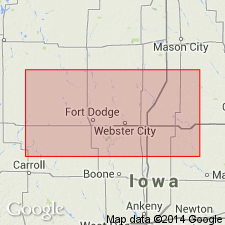
- Usage in publication:
-
- Alden limestone
- Modifications:
-
- Overview
Summary:
Pg. 245. Alden limestone of northern central Iowa is unconformably overlain by St. Louis limestone, unconformably underlain by Hampton formation, and is = Salem [Spergen] limestone.
Source: US geologic names lexicon (USGS Bull. 896, Gilmore City entry p. 820-821).
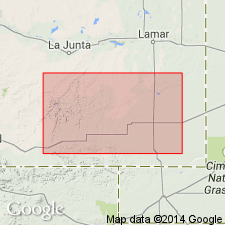
- Usage in publication:
-
- Gilmore City limestone*
- Modifications:
-
- Areal extent
- AAPG geologic province:
-
- Anadarko basin
Summary:
Gilmore City limestone. Extended into the subsurface of Baca County, Colorado, in the Anadarko basin. Consists of a lower cream to buff, oolitic to pisolitic, crinoidal limestone, about 39 feet thick; and an upper white, finely sandy, oolitic limestone, about 15 feet thick. Overlies Misener sand and underlies Burlington limestone. Age is Early Mississippian (Kinderhookian). Report includes correlation chart.
Source: Modified from GNU records (USGS DDS-6; Denver GNULEX).
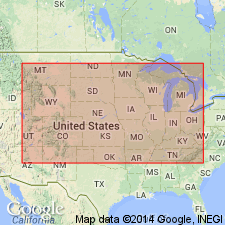
- Usage in publication:
-
- Gilmore City limestone
- Modifications:
-
- Revised
- AAPG geologic province:
-
- Iowa shelf
Summary:
Pg. 101, 146, 150, chart 5. Gilmore City limestone of Easly group. Shown on standard Mississippian stratigraphic section as uppermost formation in Easley group (new) underlying Fern Glen formation and overlying Sedalia formation. In Iowa overlies Iowa Falls dolomite. Also termed Alden formation.
Source: US geologic names lexicon (USGS Bull. 1200, p. 1511).
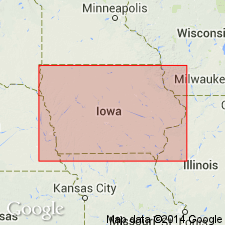
- Usage in publication:
-
- Gilmore City limestone
- Modifications:
-
- Areal extent
- AAPG geologic province:
-
- Iowa shelf
Summary:
Pg. [3-5, 17-18]. Gilmore City limestone. Van Tuyl (1925) considered that there was an erosional surface of about 75 feet of relief upon Iowa Falls dolomite and that Gilmore City limestone was decidedly younger than Iowa Falls dolomite. Present study suggests that Iowa Falls dolomite is in part a dolomitized lateral equivalent of Gilmore City limestone.
Source: US geologic names lexicon (USGS Bull. 1200, p. 1511).
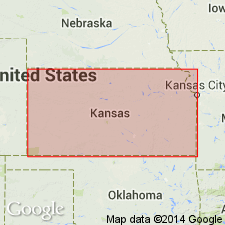
- Usage in publication:
-
- Gilmore City Limestone*
- Modifications:
-
- Overview
- AAPG geologic province:
-
- Anadarko basin
- Salina basin
Summary:
(Paleozoic Era; [Cambrian through Mississippian Systems] by E.D. Goebel, p. 11-21.) Gilmore City Limestone. Noncherty, soft, chalky limestone enclosing granules of broken calcareous fossils. Some zones are characterized by oolites, including some of irregular shape and black color. In western Kansas, the formation is oolitic limestone and locally contains traces of chert. Occurs [in subsurface of Kansas], northeast and west of the Central Kansas uplift. In northeastern Kansas it lies disconformably upon Sedalia Dolomite. It thickens northwestward from 0 feet in Leavenworth County to 76 feet in Cloud County. In western Kansas the Gilmore City thickens from 0 feet in Clark and Meade Counties to more than 150 feet in northwestern Kansas. Age is Early Mississippian (Kinderhookian).
Source: Publication.
For more information, please contact Nancy Stamm, Geologic Names Committee Secretary.
Asterisk (*) indicates published by U.S. Geological Survey authors.
"No current usage" (†) implies that a name has been abandoned or has fallen into disuse. Former usage and, if known, replacement name given in parentheses ( ).
Slash (/) indicates name conflicts with nomenclatural guidelines (CSN, 1933; ACSN, 1961, 1970; NACSN, 1983, 2005, 2021). May be explained within brackets ([ ]).

